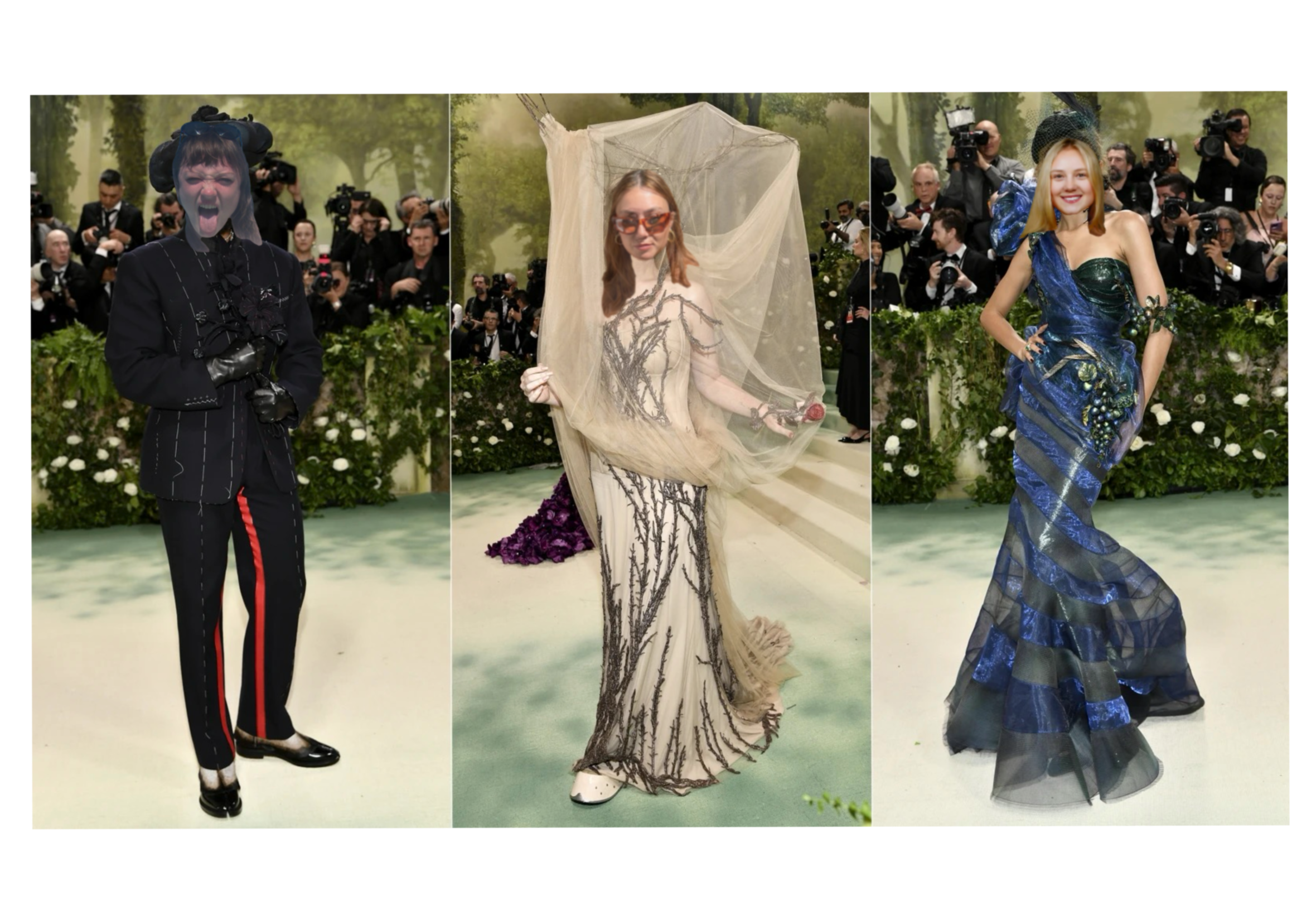Looking for Inspo From the Biggest Night in Fashion? Look Somewhere Else.
As Chris Hemsworth and his wife (whom no one knew existed until that fateful night) step onto a foliage-filled green carpet, my roommate remarks that they look like Greek Gods, casually and unattainably beautiful in embodying this year’s ethereal theme: “Garden of Time” (based on a 2024 exhibit “Sleeping Beauties: Reawakening Fashion”). Certainly, there is an element of worship in viewing the Met Gala, gawking at the unreachable divinity of stardom.
Photo source: AP News (Met Gala), Edited by Isa Montes
Like many connected young people, I dabble in idolizing, or maybe mostly scrutinizing, celebrities. So I spent my Monday night critiquing cultural icons from the high horse of my musty couch while munching on microwave popcorn.
The Met Gala, hailed as the biggest night in fashion, needs no introduction.
But the evolving culture towards the Met Gala might. Since social media’s wildfire outbreak, at-home viewing has played a much more prominent role in how we perceive The Met.
Once a primarily televised event, many young people now partake in gobbling down Met looks by scrolling through Vogue or NYT Style on Instagram, watching the event’s live stream (again via Vogue), or accessing YouTube interviews mediated by Emma Chamberlain for the fourth year in a row (from, again, Vogue). Commoners like us college students stay glued to phone screens and live streams trying to distinguish, colloquially, cataclysmic flops from earth-shattering slays.
And while there is so much joy in judging the ultra-rich, celebrity-status, Ozempic-thin women that march–or in Kim Kardashian’s case, wobble while wheezing for breath–down the runway, I find that the biggest night in fashion is relevant to most only for this plebeian-wrought judgment, rather than turning to the stars for up-and-coming fashion inspiration.
We’re all going to have opinions on who wore what, and we’re all entitled to those opinions. But they frankly aren’t pertinent (unless you believe, correctly, that Chloë Sevigny takes the cake for best-dressed on the forest-toned carpet, or if you concur that Jeff Goldblum looked like a snack).
While The Met affords a wonderful opportunity to express adoration or contempt for gowns that often cost significantly more than a year of rent (the most expensive gown, worn by Kim Kardashian in 2022, fell just short of $5 million), it isn’t a place to find your TKE Gala gown.
In the wake of events of this caliber, fast fashion sites propagate poor renditions of designer fashion as early as the following morning, cheap suit jackets cropping up like weeds, flimsy gowns spilling over like rats from sewers.
Ellie Griffith, junior and second-hand fashion connoisseur, describes to me the Sisyphean task of staying up to date with cyclonic trend cycles.
“I think there’s an interesting aspect of big fashion events where you see the trickle down–turning inspiration into fast fashion,” she elaborated. “You can get the look for cheap prices but stay with the trends. But the reality is you’re never going to catch up. All you’re doing is creating more clothing, more waste, rather than allowing yourself to be inspired by the clothing you already have.”
No matter how much you love that one dress, I urge you not to buy it. Shein’s rendition, made with the love and care of child labor, isn’t likely to come close to Kendall Jenner’s archival never-before-worn Givenchy couture.
Junior Michale Freitag, President of Santa Clara’s fashion club, thinks fast fashion has devalued our appreciation of the relics debuted at The Met.
“Fast fashion has plagued the world for ten years,” he said. “It’s the number two cause of pollution globally. It’s made our perspective of clothing change so much. We have access to the Met looks at our fingertips, and we’re accustomed to instant gratification–being able to go and get any clothing we want in fast fashion. If anything, the Met Gala is indirectly promoting companies like Shein or Zara to create cheaper versions of something worn on the carpet. It’s no longer art, it’s all commerce.”
While, shockingly, the whole event amassed to a grand-scale self-promo for news outlets like Vogue, the fashion goliath took a newer path in what they promoted this past year. In collaboration with Outer Bank’s star Madeline Cline, Vogue and eBay teamed up to furnish the actress with vintage designer accessories. While many stars took similar notions, either pulling archival pieces or piecing together fragments of old pieces, as Penelope Cruz did exquisitely, shopping second-hand with platforms like eBay, Poshmark or ThredUp is the most accessible way to get in on the vintage trend.
If, like me, you ball on the budget allocated by a few hours a week at your on-campus job, it isn’t likely you’ll be granted access to the gilded gates of High Fashion. But, finding one-of-a-kind articles at local curated vintage stores can create a diverse repertoire of pieces that are equally fulfilling and highly fashionable, but a far cry from the back-breaking cost of High Fashion.
(And if you do have the bank for the elusive High Fashion, you can get far more commendably cool items by buying vintage designer.)
In the spirit of this year's Met Gala, I urge you to turn away from online recreations of designer looks. Interpreting trends the same as the ultra-rich might amount to what my mother calls mutton done up as lamb. Definitely don't follow the peek-a-boo-upper-butt crack trend–even if you did look like Emily Ratajkowski, we wouldn’t want to see all that at Farmageddon. But you can rework the gala’s thematic suggestion by reawakening slumbering pieces from online or local thrift and antique stores, finding your own “archival” pieces by buying vintage.
